 |
| An aerial view of fairy circles — mysterious bare spots that occur in deserts around the world. Photo: N. Juergens |
In the Australian outback, some grasses grow in eerie rings, with ramparts of dusty green standing at the edge of wide circles of bare red desert. Often described as “fairy circles,” these rings of spinifex grass resemble structures first spotted in the Namibian desert, both creating enormous honeycomb patterns across the landscape that pop out in aerial photos. In Namibia, scientists have deployed cameras on fishing rods, observed termite colonies and even used mathematical models to try to explain how this phenomenon arises.
Follow Phillip
In The contribution of pathogenic soil microbes to ring formation in an iconic Australian arid grass, Triodia basedowii (Poaceae), published in the Australian Journal of Botany, researchers suggest that microbes living in the soil may contribute to the rings’ formation in Australia, rendering the soil within the ring hostile to new seedlings and the soil beyond the ring hospitable.
But in other parts of the world where Fairy Circles have been more extensively studied, the debate continues as to whether competition between species, termites or other factors may be responsible for these mysterious natural phenomenon.
Although the name fairy circles sounds sweet and peaceful, there is passionate scientific disagreement over how they arise, and the two prevailing hypotheses have become adversaries in the dispute.
One side suggests that termites, locked in never-ending competition with neighboring colonies, create the circles as they fight for dominance and resources. The other says that perpetually thirsty plants simultaneously assist and compete with their neighbors’ roots, causing the vegetation to “self-organize” into the patterns.
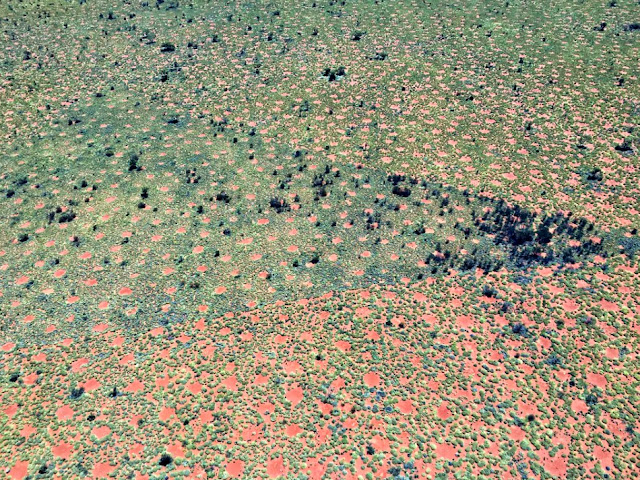 |
| Do plants build fairy circles? Photo: Brad Howe |
Spinifex grasses start out as small round hummocks, said Angela Moles, an ecologist at the University of New South Wales and an author of the study. Then, as new seedlings sprout outward, the plants in the middle die, leading to the ring shape. Researchers have explored whether the bare inner soil becomes depleted of nutrients; whether it is too dry or compacted for new growth; and whether insects might be destroying the spinifex. But a consensus on what is driving the formation of rings has yet to emerge.
Dr. Moles had heard of a small European swamp grass that grew in a ring pattern, a result of a buildup of soil pathogens in the middle. She and Neil Ross, a graduate student in her lab, were curious whether sterilizing the soil from inside rings, thus killing any microbial organisms there, would make it easier for plants to grow in it. If so, that would imply that microbes were involved.
Mr. Ross carefully scooped soil from the interior of rings in the desert of Australia’s Northern Territory, and from outside the rings as well. Back at the university’s greenhouses, he sterilized some of each. He then planted some spinifex seeds in pots of microbe-free soils and some in unaltered soils.
The seeds germinated more easily in containers of interior soil that had been sterilized, the researchers found. About the same number of seeds germinated in soil from outside the rings that had not been sterilized, suggesting that outer soil and sterilized inner soil both encouraged new growth. Sterilizing the inner soil seemed to remove whatever was keeping plants from sprouting.
 |
| A circle of spinifex grass in Alice Springs, Northwest Territory, Australia Photo: Genevieve Vallee |
The Janzen-Connell Hypothesis
This fits with earlier research suggesting that as plants grow, pathogens that attack them take up residence in the soil around their roots. These pathogens may be tolerable for adult plants but unpleasant for fragile new seedlings, a difference that may help explain why in rain forests, trees of the same species are seldom found near each other.
The Janzen-Connell Hypothesis is a widely accepted explanation for the maintenance of tree species biodiversity in tropical rainforests. It was published independently in the early 1970s by Daniel Janzen and Joseph Connell. According to their hypothesis, host-specific herbivores, pathogens, or other natural enemies (often referred to as predators) make the areas near a parent tree (the seed-producing tree) inhospitable for the survival of seedlings. These natural enemies are referred to as 'distance-responsive predators' if they kill seeds or seedlings near the parent tree, or 'density-dependent predators' if they kill seeds or seedlings where they are most abundant (which is typically near the parent tree). Such predators can prevent any one species from dominating the landscape, because if that species is too common, there will be few safe places for its seedlings to survive.
 |
| The original aerial photo that interested scientists |
“Germinating is a really scary thing for a seed,” Dr. Moles said. “For a while there, they don’t have a lot of resources.”
If new spinifex grasses can’t handle the pathogens in the soil at the center of their clump, they may sprout instead just outside of it, leading to that signature ring pattern.
However, the researchers also found that sterilized soil from outside the ring was just as bad for new sprouts as untreated inner soil. Dr. Moles speculates that some other soil microbes can also help seedlings. Killing potential pathogens from inside the ring makes that soil livable again, she says, but killing everything in the soil outside it might have detrimental effects as well.
The researchers did not attempt to culture bacteria or other microorganisms from the soil, so they are not sure what tiny ecologies have sprung up around these rings in the desert and exactly how they change over time. But in the ongoing scientific discussion of these fairy rings, microbes may have just joined the party.
 |
| Photo: Jenguyton.com |
Clues to Origin of Namibia's Fairy Circles
With its bone-dry grasslands and oppressive heat, the middle of the Namib Desert may seem like a strange place to go fishing. Yet there Conservation Photojournalist Jennifer Guyton and Ecology and Evolutionary Biology scientist Tyler Coverdale were, standing in a sea of orange sand and brittle yellow grass with their 30-foot carp pole. The two Princeton alumni had swapped the hook with a camera so they could investigate the scenery around fairy circles.
 |
| Fairy Circle ring of spinifex grass, Namibia Photo: MJ Photography |
That is what scientists call the mysterious bald spots speckled across Namibia’s grasslands. The rings are six feet to 115 feet wide and are regularly spaced out in a hexagon or honeycomb pattern. As their ethereal name would imply, fairy circles have long bewildered researchers as to their origins. But a 2017 Journal of Nature study, A theoretical foundation for multi-scale regular vegetation patterns (by Tarinta et. al. that Drs. Guyton and Coverdale co-authored) seeks to offer some insights into how the enchanting landscapes may have formed.
This study suggests that termites and plants may be jointly responsible for forming fairy circle landscapes in Namibia. And it has received mixed reviews from scientists entrenched in the dispute.
“We thought both sides of the debate bring in compelling arguments for each of these mechanisms, so why should it be one or the other?” said Corina Tarnita, an ecologist from Princeton University and the study’s co-lead author.
Dr. Tarnita worked with Juan Bonachela, a mathematician from the University of Strathclyde in Scotland, to test the termite and plant explanations in a computer model. They found that either hypothesis could generate the fairy circle features. But when they tested both mechanisms together, the model revealed a second, smaller pattern hidden within the clumps of grass between the fairy circles.
“Everyone was focusing on the circles and not what was happening in between them,” said Robert M. Pringle, an ecologist at Princeton and another author on the paper.
The next step for the team was to confirm that this second vegetation pattern existed in nature. So they sent Ms. Guyton and Mr. Coverdale to Namibia in 2015 with their camera and fishing pole.
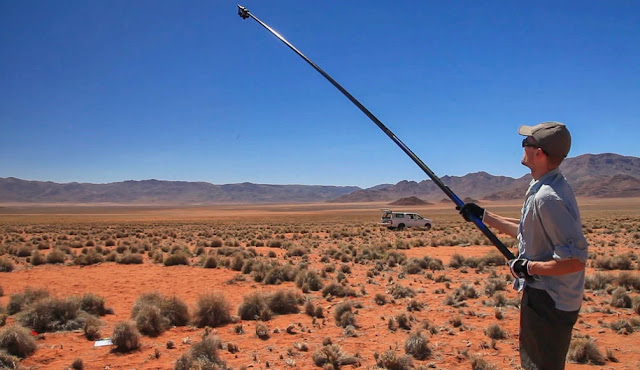 |
| Dr. Tyler Cloverdale photographing a Namibian Fairy Circle |
Ms. Guyton said that each of the grassy patterns was as different as fingerprints, but were mathematically similar. By comparing the photos with their model, the team verified that the second pattern did exist in the grass surrounding the Namibian fairy circles. That finding, they said, confirmed that their mathematics reflected reality and suggested that only by interacting together could insects and plants create the landscape that characterizes Namibian fairy circles.
Some fairy circle experts firmly placed in either team termite or team plant had strong doubts about the paper’s findings, while others welcomed it.
Norbert Juergens, a biologist from the University of Hamburg in Germany who authored The Biological Underpinnings of Namib Desert Fairy Circles said termites engineer fairy circles agreed with the overall findings and said that he hoped they would “be an eye-opener for all those who since 2013 questioned the termite hypothesis.”
 |
| Photo: Stephan Getzin |
Stephan Getzin, an ecologist at the Helmholtz Centre for Environmental Research in Leipzig, Germany, was not persuaded, saying in an email that the paper was unable to account for the presence of fairy circles where sand termites were completely absent, as in Australia.
“Logically, if there are fairy circles without the presence of termites, the termite theory cannot be considered as a strong explanation for the phenomenon,” he said.
Dr. Tarnita responded that their model showed that both termites and plants could make the fairy circles, but that the entire system, which includes the vegetation and the small-scale patterns seen in the Namibian fairy circles, needed both.
Walter R. Tschinkel, a retired entomologist from Florida State University who was not involved in the study, said in an email that the assumptions the team made about termites in their computer model were untested.
 |
| Photo: Stephan Getzin |
“There is no evidence that the real termite Psammotermes allocerus does what the computer ‘termite’ does,” he said.
But Max Rietkerk, an environmental scientist from Utrecht University in the Netherlands, said that the authors showed that the two hypotheses could have worked together in Namibia’s fairy circles. He also agreed, however, that the argument could use more empirical evidence.
Dr. Pringle defended the use of their model, pointing out that it drove the team to discover new empirical evidence that no one had found before, the small-scale grass patterns.
Despite the team’s attempt to solve the mystery, it seems the fairy circle debate flutters on.
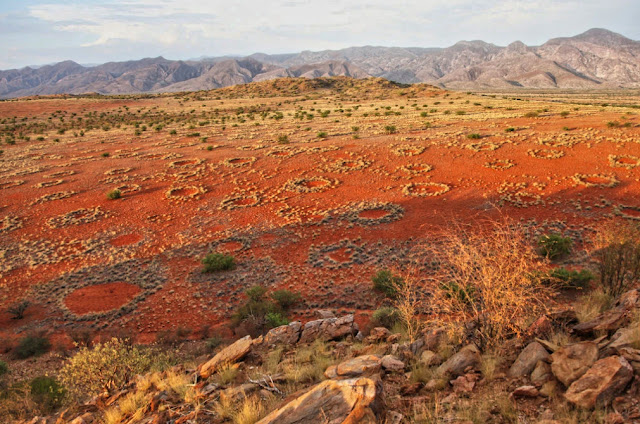 |
| These fairy circles occur in a narrow belt of desert stretching from Angola through Namibia into northern Africa. Photo: N. Juergens |
Fairy Circles in Africa May Be Result of Termites
Reddish barren spots, thousands of them, dotting the South African desert grasslands are called fairy circles, the name itself an invitation to try to solve the mystery of their origins. They occur in a narrow belt of desert stretching from Angola through Namibia into northern South Africa. For no obvious reason, the round patches of sandy soil interrupt the arid grassland, like a spreading blight on the land.
To the Himba people who live in the region, however, there is nothing to explain. That’s just how it is, they tell anthropologists; the circles were made by their “original ancestor, Mukuru,” or more poetically, they are “footprints of the gods.” A just-so story blames a mythical dragon that lives in a crack deep under the earth. The dragon’s poisonous breath kills vegetation to create the circles. Trouble is, some scientists point out, the bad-breath hypothesis apparently originated with fanciful tour guides.
 |
| Namibian Fairy Circles Photo: Hoberman Collection |
New research may now have yielded a more credible explanation for the fairy circles as examples of natural ecosystem engineering by a particular species of sand termites, Psammotermes allocerus. A German scientist reported on Thursday that most likely these industrious termites were the agents for making much of their desert home an oasis of permanent grassland.
In The Biological Underpinnings of Namib Desert Fairy Circles Norbert Juergens, a professor of ecology at the University of Hamburg, said these termites “match the beaver with regard to intensity of environmental change, but surpass it with regard to the spatial dimension of their impact.”
Over the 1,200-mile length of the Namib Desert, especially in parts of Namibia, Dr. Juergens wrote, “P. allocerus turns wide desert regions of predominately ephemeral life into landscapes dominated by species-rich perennial grassland supporting uninterrupted perennial life even during dry seasons and drought years.”
 |
| Fairy circles viewed from above in the NamibRand Nature Preserve, Namibia Photo: Kymri Wilt/Danita Delimont |
Last year, Walter R. Tschinkel, a biologist at Florida State University, published an analysis of aerial and satellite photography and other research to describe the number, size and dynamics of these formations. Some are as small as six feet in diameter and never grow much bigger. The largest ones can be at least 40 feet across. It was estimated that the smaller circles have average life spans of 24 years, the larger ones as much as 75 years.
But Dr. Tschinkel had first assumed that termites were implicated and went looking for nests of a different species, harvester termites, without success. He finally concluded that no other termites had been associated with the circles, and seemed resigned to a mystery unsolved.
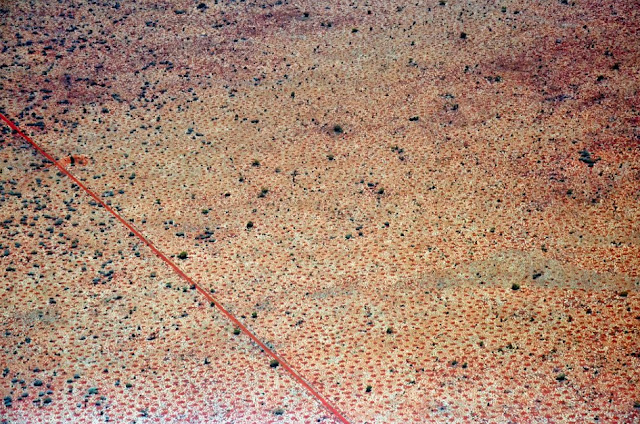 |
| Fairy Circles Australia Photo: Stephan Getzin |
In a critique, Dr. Tschinkel said he was unconvinced that the termites are the cause of the circles. He said the paper by Dr. Juergens “has made the common scientific error of confusing correlation (even very strong correlation) with causation.”
Scientists at the University of Pretoria in South Africa have also tested hypotheses of escaping natural gases like methane or other toxins rising to the surface and wiping out vegetation at these spots. But the results have been inconclusive.
Dr. Juergens argued that Dr. Tschinkel was “looking for the wrong termites and you could easily overlook the ones that were actually living” deep beneath the surface of the red sandy spots, feasting on grass roots to keep the patches of land free of vegetation. In this way, the soil is better able to absorb rainfall quickly, with little water loss due to evaporation. The absence of vegetation at the site also means that rainwater is not lost through transpiration, the evaporation of water from plants.
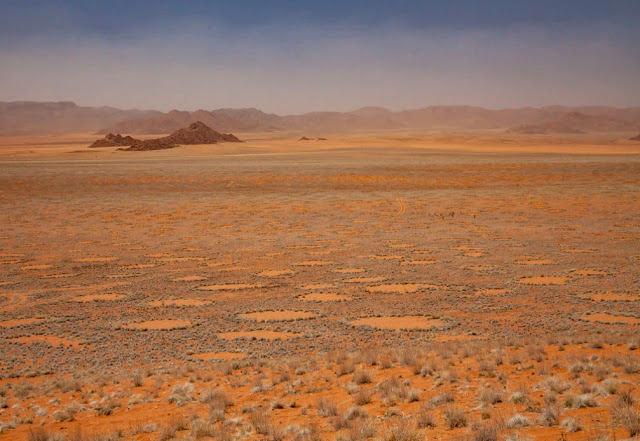 |
| Fairy Circles Namibia Photo: Jen Guyton |
The absorbed water, the scientists explained, spreads evenly in the sandy soil all around, which explains the circular patterns. This nourishes the surrounding grassland. And the termites keep chomping the roots of new shoots from beneath the inner circle, preventing new vegetation from disrupting their engineered ecosystem.
Another critical factor, Dr. Juergens said, is that all the circles he and associates examined methodically over 40 field trips in the last six years had two telling characteristics. P. allocerus termites were present in all, and the soil was extremely sandy and porous.
They found strong evidence, Dr. Juergens said, that the species does “things not done by other termites. They are “quite clandestine,” he noted. They build no nests or mounds above ground. Their underground galleries and passages are deep and narrow. “They sort of swim in the loose sand, not leaving tracks,” he said.
The researchers observed that the circles occur only in sandy soil, not where clay predominates. And they studied the presence of the termites in the earliest stages of a circle’s formation, establishing that they were in on its creation, not merely occupying it at later stages. They also were involved in widening the diameter of the circles, as they steadily fed on grasses at their outer margins.
In dry seasons, the termites can remain alive and active by moving out from the circles, still underground, and surviving on roots of the outlying grasses.
David P. Crandall, an anthropology professor at Brigham Young University in Utah who has studied the Himba people closely since 1990, said the fairy circles “are a strange and interesting phenomenon” that is vital to their sparse population spread over an area about half the size of Arizona. Even though the people appear to have little curiosity about why the circles are there, they depend on the grasses around them to graze their cattle, goats and sheep.
The Himba sometimes put the barren spots to new uses. Examining some Google maps, Dr. Juergens was puzzled by what appeared to be black margins to the circles in some pictures. Going to the sites, he found that they had erected temporary wooden fences to corral young cattle overnight, as protection against lions and other predators.

No comments:
Post a Comment